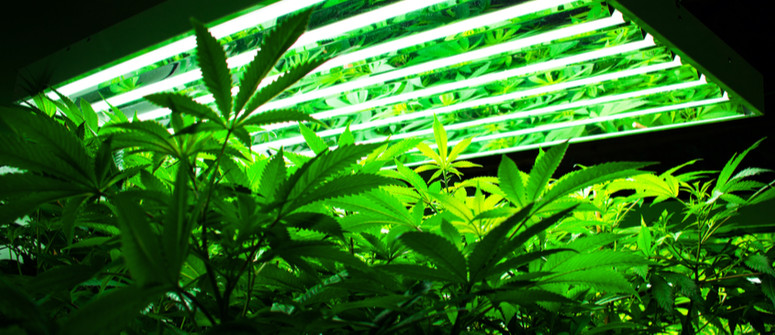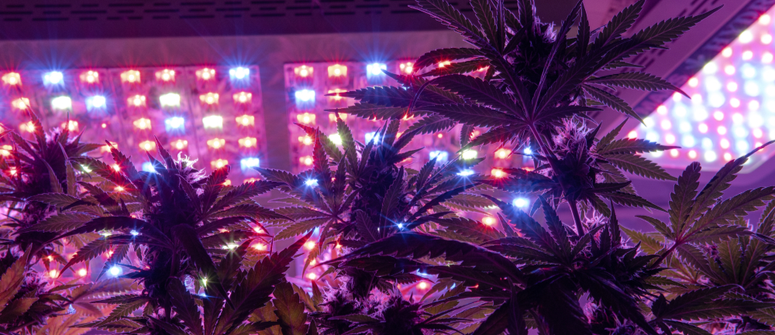What are the best grow lights for cannabis?

When it comes to growing cannabis, there's one thing you can't be without—light! Keep reading for a complete guide to grow lights, their pros and cons, and which one you should pick for your cannabis plants.
Contents:
- Why Is Light Important for Growing Cannabis?
- Grow Light vs Regular Light: What's the Difference?
- What Are the Best Lights for Growing Cannabis?
- LED Lights for Growing Cannabis
- Fluorescent Lights for Growing Cannabis
- High-Intensity Discharge (HID) Lights for Growing Cannabis
- Tips on Using Cannabis Grow Lights
- How To Choose the Best Cannabis Grow Lights?
You can have the most sophisticated grow room in the world, but, without light, your cannabis plants won't even make it past germination. Light is a fundamental building block of cannabis cultivation, making it essential you know exactly how to give your plants the light they deserve.
To do that, you'll need a grow light. But, with dozens to choose from, how do you know which one is right for your grow space? Before we take a look at the different grow lights, how they work, and their pros and cons, let's first recap why light is fundamental for cannabis cultivation.
Why Is Light Important for Growing Cannabis?
The importance of light comes down to one word—photosynthesis. Photosynthesis is the process plants use to turn light energy into chemical energy, helping them grow, resist disease, synthesise nutrients, and, most importantly, develop dense, resin-laden buds!
Most cannabis plants are photoperiodic, and, in the wild, flower according to the seasonal changes in light exposure. Indoor lighting needs to mimic these conditions; so, for light coverage, you'll want to stick to the following schedule (hours of light/hours of darkness):
• Seedling: 20/4
• Vegetative: 18/6
• Flowering: 12/12
Given how long lights will be running from start to finish, you'll want to commit to a unit with running costs that match your budget. We'll cover more on the running costs of different lights later on, but, for now, let's take a quick look at another critical consideration—light spectrum.
What About the Light Spectrum?
Growers can boost photosynthesis by exposing cannabis plants to different light spectrums. The trick, of course, is knowing which colours of visible light impact cannabis, and when. The seven colours of light that make up the visible spectrum (between 380 and 750nm) include violet, indigo, blue, green, yellow, orange, and red. Cannabis benefits from two colours in particular:
• Vegetative stage: Cannabis favours blue light (400–500nm)
• Flowering stage: Cannabis favours red light (620–780nm)
Most grow lights will feature a selection of colours from the visible spectrum, in which case you needn't worry. However, some advanced units include a veg and bloom function that alters the light spectrum accordingly. If you opt for these units, ensure you're using the right setting to maximise yields.
Grow Light vs Regular Light: What's the Difference?
While it may be tempting to take a lamp out of your spare room and position it over your marijuana plants, regular lights just won't cut it. We've already highlighted the importance of light coverage and spectrum for cannabis growing, but you'll also need to factor in light intensity.
Most regular lights mimic natural daylight, not only making them weaker than a grow light (low-wattage), but lacking in a full spectrum of visible colours. Grow lights are engineered specifically to provide the conditions cannabis plants need to thrive. By having a higher wattage than regular lights, grow lights give off a much brighter, more intense light that not only drives photosynthesis, but penetrates deep into your cannabis canopy for improved exposure.
Trust us when we say that no matter how many standard bulbs you position above your weed plants, they will never match a dedicated grow light's efficiency and power.
Calculating Yields Based on Wattage
To emphasise how crucial the right light is for cannabis growing, many use a simple calculation involving wattage to estimate their crop's final yield:
• Every watt of power equates to a certain number of grams (of bud), depending on the grow light's specs.
For example, if you buy a 200W LED grow light (remember to use the true power draw), the final yield should be around 100–360 grams.
Estimated Yield per Light (Grams per Watt)
• LED: 0.5–1.8g/watt
• CFL: 0.3–0.5g/watt
• HID: 0.5–1g+/watt
• LEC: 1.5g/watt
These calculations are by no means a guarantee, as the final output also depends on grower skill, conditions, and strain. Instead, think of them as targets to work toward.
What Are the Best Lights for Growing Cannabis?
With the importance of light, and, more specifically, grow lights outlined for cannabis cultivation, it's time to move on to the meat and bones of this guide—the different types of grow lights available.
All of the lights listed below are fully capable of growing great cannabis, but it's important you match the grow light to your setup and overall experience. To find the best grow lights for your setup, you'll need to know how each one measures up.
LED Lights for Growing Cannabis
The newest kid on the block, LED grow lights are making waves in the cannabis scene for their low running cost and consistent results.
What Are LED Grow Lights?
LED, or light-emitting diode, grow lights have become increasingly popular for growing weed. Early iterations of LED grow lights couldn't match the intensity of traditional options, but the technology is continually improving, and LEDs are proving a formidable option.
It's worth noting that many LED panels include a daisy chain system, allowing you to link units together for improved control, coverage, and efficiency. It's also common to find veg and bloom settings on LED panels (full-spectrum LEDs), making them a versatile pick for novice and experienced growers.
Spread-Style LED Grow Lights
Spread-style LED grow lights include a few notable models, including spider-style, rack, and quantum boards. The most popular option remains the quantum board, which, in essence, is a large light panel with LEDs spread out over its surface. Quantum boards provide excellent coverage due to their large size, but tend to be lower in wattage than other styles.
Traditional Panel LED Lights
Traditional LED panels are the compact counterpart to the spread style units highlighted above. They use the same technology, but favour intensity over coverage. Traditional LED panels are also more common among home marijuana growers, as they offer an excellent middle-ground between size, wattage, and overall cost.
COB-Style LED Lights
COB lights still use a series of smaller LEDs, but this time they're clustered closer together to give the impression a panel is only 4–6 bulbs. COB lights have the greatest intensity of all LED panels, but at the cost of power efficiency. The deep light penetration from COB panels is ideal for several large plants, but any more than that and coverage can become an issue.

Pros of LED Grow Lights
• Energy efficient (lower overall running costs)
• Run significantly cooler than traditional grow lights
• Less heat out means less cooling and heat-related plant problems
• Many models have a veg and bloom setting for a full-spectrum lighting solution
• Plug and play
Cons of LED Grow Lights
• The initial cost of LED lights is more significant than other grow lights
• The quality of LED panels varies significantly
• Not the greatest yield potential (yet)
• The wattage advertised is not always the true power draw
Fluorescent Lights for Growing Cannabis
Fluorescent lights are a popular option for home growers because they're cheap, easy to get hold of, and ideal for every phase of cannabis cultivation.
What Are Fluorescent Grow Lights?
If you're a beginner experimenting with cannabis for the first time, CFLs and T5 grow lights are an excellent choice. There are plenty of different styles to choose from, with most available in local hardware stores.
Fluorescent grow lights work well with cannabis and various other plants, while offering a respectable balance between output and running cost. If we had to rank fluorescent lights, they would be the best all-round pick—they won't excel in any area, but they won't let you down either.
Compact Fluorescent Lights (CFLs)
Easily recognisable by their twisty shape, CFLs provide excellent light coverage, intensity, and not too much heat. They're easy to work with and won't break the bank. While CFLs won't award the greatest possible yields, they are dependable.
If the worst happens and they break, they're easily replaceable. Even if you opt for a more expensive option from our list, it never hurts to have a few CFLs on standby.
T5 Grow Lights
Incorporating more of a panel design, T5 grow lights are great for cannabis plants from germination to the flowering stage. However, just like CFLs, they won't deliver crazy yields, but they are reliable. T5 grow lights won't produce a ton of heat either, allowing you to position them close to plants without the risk of burning or scorching. Another solid pick for novice growers.
Pros of Fluorescent Grow Lights
• Cheap to buy and run
• Minimal heat output
• Ideal light spectrum for cannabis
• Well-suited to small grow tents
Cons of Fluorescent Grow Lights
• Smaller overall yields
• Poor light penetration (you need to position lights close to the canopy)
• Won't last as long as other types of grow lights
High-Intensity Discharge (HID) Lights for Growing Cannabis
With high-intensity light comes great cost and great heat, but arguably the greatest possible yield. If you're serious about getting the most from cannabis plants, look no further.
What Are High-Intensity Discharge (HID) Grow Lights?
The clue is in the name, but all HID grow light types excel at providing high-intensity light for your cannabis plants. That intensity does come with some caveats, but provided you can keep conditions (and cost) on track, your reward will be an abundance of juicy buds.
It's common for growers to use more than one type of HID during cannabis cultivation, with certain types more suited to the vegetative or flowering phase.
Metal Halide (MH) Grow Lights
More popular for the vegetative stage, metal halide grow lights emit a slightly bluish light. You can, of course, use them for the entire grow, but during the latter stages of growth, growers tend to switch to the HPS grow lights listed below.
The significant difference with HID grow lights, including metal halide, is the need for extra components, such as the bulb, reflectors, and a ballast. It's an added layer of complexity that may deter beginners. Still, metal halide grow lights are a mainstay among cultivators as they have years of good results under their belt.
High-Pressure Sodium (HPS) Grow Lights
HPS grow lights also have bulbs, a reflector, and ballast, but, this time, the light given off is reddish and slightly better suited to the flowering stage. Don't worry, though; you can easily use an HPS grow light from seed to harvest. The most important consideration with HPS lights is the heat they create—it's a lot!
You'll need a way to vent heat out of your tent, and the hanging position is crucial to avoid damaging plants. Meet these requirements, though, and HPS lights can deliver some serious yields.
Ceramic Metal Halide (CMH) / Light-Emitting Ceramic (LEC)
LEC grow lights, aka ceramic metal halide lights, take the benefits of standard HID-style units one step further. Provided you can stomach the initial cost (€250–1000), they're more compact, longer-lasting, and deliver a balanced light spectrum.
LEC grow lights also have the greatest potential return (grams per watt), making them an attractive option for committed growers. They still pump out a lot of heat, so don't forget to provide adequate ventilation.
Pros of High-Intensity Discharge Grow Lights
• Initial cost of metal halide and high-pressure sodium grow lights is reasonable
• Straightforward to use
• Excellent yield potential
• Cannabis growers swear by them
Cons of High-Intensity Discharge Grow Lights
• Extra equipment needed (bulb, ballast, reflector)
• Generate lots of heat
• HID bulbs have a limited shelf life
• Expensive running costs
Tips on Using Cannabis Grow Lights
You can harness several tricks and tips to maximise the light inside your grow room or tent—and they don't involve spending lots of money on expensive units. Where possible, try to apply the tips below to give your plants the light they deserve:
• Try not to touch bulbs (residue from your hands can decrease their efficiency)
• Hang lights as close to the canopy as possible without harming your cannabis plants
• Keep equipment in good condition, and make sure you replace bulbs as necessary
• Add reflective material to the inside of your grow tent or room to improve coverage
• Add a reflector to your grow light to maximise coverage and intensity
How To Choose the Best Cannabis Grow Lights?
Picking the best grow light for you may seem like a daunting prospect, but know that all of the lights listed above can grow great-quality weed in the right circumstances. Even the cheapest LED grow light will give you some return; it just may not be as much as you hoped.
Our tips for choosing the best grow lights include:
• If you're only growing a few plants, stick with inexpensive CFLs
• If you are thinking more long-term, an LED unit is a worthwhile investment
• Large grow spaces are best equipped to handle HID grow lights (MH for veg and HPS for bloom)
• Calculate the total costs (initial and running) before committing
• Keep things simple: unless you're an experienced grower, use the same grow light from seed to harvest
If we had to offer one final piece of advice, it would be to err on the side of buying a more expensive grow light than a cheap one—even if it's standard CFLs. With nearly all other aspects of cannabis growing, you can keep things cheap and cheerful, but light is one factor you should invest in.
.jpg)


.jpg)
